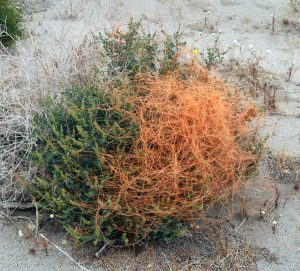
Dodder is a group of ectoparasitic plants with about 150 species in a single genus, Cuscuta, in the morning glory family (Convolvulaceae) or Cuscutaceae, depending on the classification system used. These pale green or yellow, bright orange or red plants, found throughout tropical and temperate regions of the world, have been given all sorts of common names alluding to the string-like appearance of the plants: angel hair, devil’s hair, devil’s ringlet, goldthread, hairweed, lady’s laces, strangleweed, witch’s hair and many others.
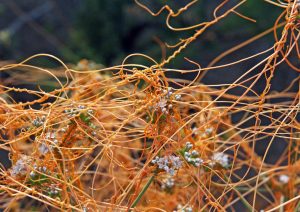
These plants have very thin, sting-like twining stems that appear to be leafless. They do have leaves but they are reduced to tiny scales that are barely visible. Most species have very low levels of chlorophyll, so are not green. Because of the lack of chlorophyll most produce very little food on their own and therefore depend on their host plants for nutrition. The plants cover their host plants in a spreading, tangled mass of intertwined stems, especially where growing in full sun (twining and attachment is greatly reduced in shaded areas).
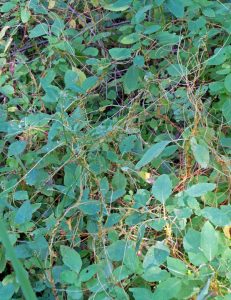
Dodder species are variable in the habitat they are found in naturally and the number of different host species they can infect, with some restricted to just a few host plant species and others able to infect a wide range of hosts. A wide variety of herbaceous and small woody plants can be parasitized by dodder, including many agricultural crops such as alfalfa, asparagus, carrots, cranberries, onions, and potatoes, as well as many ornamental plants, including chrysanthemum, dahlia, helenium, impatiens, English ivy, periwinkle, petunia and trumpet vine, and many weed species including field bindweed (Convolvulus arvensis), lambsquarters (Chenopodium album), and pigweed (Amaranthus species). Dodder can weaken or kill plants and reduce crops yields. The impact on the host plant varies considerably depending on the species of dodder, the growth stage and condition of the host plant, and the time of infection. Infected plants are also more susceptible to diseases and insect problems.
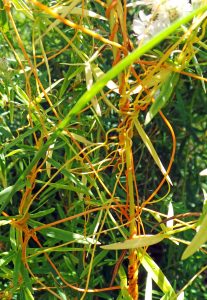
In temperate areas dodder is an annual that grows from seeds each growing season. After germination at or near the soil surface, the seedlings grow quickly toward a host plant, possibly in response to volatiles released by preferred host plants, coiling around any object it encounters. If a suitable host plant is not reached within 5-10 days the seedling will not survive. Once a suitable host plant is reached, the seedling wraps itself around the plant and produces special structures, modified adventitious roots called haustoria, that are inserted into the host’s vascular system. Once the dodder is established on the host plant its original root in the soil dies. The dodder plant then continues to grow rapidly on that host plant, continually making new attachments to the host and eventually covering it – or spreading to adjacent plants – until the dodder plant is killed by frost. Since they have to re-establish from seedlings each year, species in temperate areas are only found in relatively low vegetation, whereas species in tropical areas, where plants can grow continuously, may reach high into the canopy of shrubs and trees.
Tiny 4 or 5-parted white, yellow or pink bell-shaped flowers are usually borne in clusters (occasionally singly) in late spring to early fall, depending on the species. These are followed by small rounded fruits or seed capsules the same color as the stems that contain 2-3 seeds. Dodder is a prolific seed producer; a single plant can produce thousands of seeds. The small seeds have a hard, rough seed coat that enables them to survive in the soil up to 20 years or more, depending on the species and environmental conditions. Dodder seeds are spread primarily through the movement of soil and equipment by humans, in infested plant material or as a crop seed contaminant, and for some species by water.


Dodder is not commonly found in gardens or ornamental landscapes but if observed it should be removed immediately as dodder is difficult to control once introduced. Effective management requires a systematic approach combining several control methods over several years focused on reducing the current population, preventing seed production, and dealing with new seedlings in subsequent years. Any seedlings not yet attached to a host plant should be pulled (they are generally difficult to find, however). Once attached to a host plant, complete eradication from the host plant is usually not possible as dodder can grow back from haustoria embedded in the plant. Pruning is of little benefit unless only one or two branches are affected and can be removed without destroying or disfiguring the entire plant. Unless the plant can be pruned significantly lower than the dodder it is best to remove the entire host plant or kill both the dodder and host plant with a non-selective herbicide, such as glyphosate. If the dodder plants have already set seed, burn them (if allowed locally) or dispose of them in the trash. In areas that have been infested previously, the area should be monitored closely for the presence of seedlings and pull them as soon as they are seen or the soil can be treated with a preemergent herbicide before seeds germinate in spring. Control any weeds that could serve as hosts. If the area is planted annually, choose plants that are not susceptible to attack by dodder, such as ornamental grasses and other monocots, including lilies. In agricultural crops, dodder is managed by rotation to non-host crops, use of dodder-free seed, cleaning equipment between fields, control of weed hosts, and chemical control in infested areas.
There are many native species of dodder in Wisconsin, including common or swamp dodder (Cuscuta gronovii (= C. umbrosa) that is potentially invasive but not all dodder species are pests that need to be controlled. There are several species of native dodders in Wisconsin that are Wisconsin Special Concern plants:
-
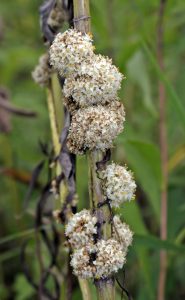
Rope dodder, Cuscuta glomerata. Photo by Aaron Carlson, Online Virtual Flora of Wisconsin at http//:wisflora.herbarium.wisc.edu.
Hazel dodder (Cuscuta coryli) is found in sandy lake margins, mud flats and moist fields. It is often found on hazelnut (Corylus spp.), as well as reported infecting aster, common milkweed (Asclepias syriaca), Mondarda, sunflower (Helianthus sp.), Canada goldenrod (Solidago canadensis), and members of the mint family (Lamiaceae) and many other plants. - Rope dodder (Cuscuta glomerata) is found in a variety of moist habitats and blooms from July through September. It can be distinguished from other Cuscuta by having the inflorescences densely bunched together giving the plant a thick, rope-like appearance. It is reported as having a preference for members of the Aster family, often on sunflower, Canada goldenrod, and spotted water hemlock or spotted cowbane (Cicuta maculata).
- Field or five-angled dodder (Cuscuta pentagona = C. arvensis, C. campestris) is found along fields and roadsides.
- Knotweed or smartweed dodder (Cuscuta polygonorum) is also found in moist habitats including wet prairies, coastal plain marshes, and the margins of commercial cranberry bogs. It is distinguished from other Cuscuta by its very short styles and its host plants including Bidens spp., Polygonum spp., Panicum capillare, Setaria glauca, Rorippa islandica, and Hypericum boreale.
Most species of dodder are on the federal noxious weed list, except some native species and a few widespread non-native species but all dodders, including the natives, require federal permits for importation or transportation of seed.
– Susan Mahr, University of Wisconsin – Madison





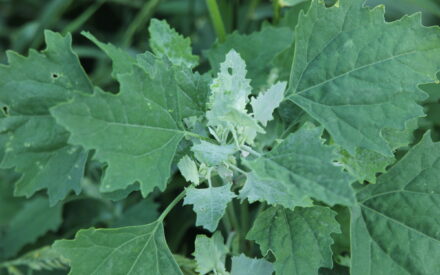 Common Weed Seedlings of the North Central States
Common Weed Seedlings of the North Central States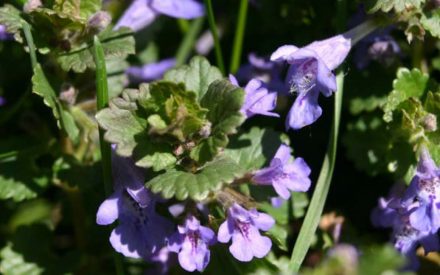 Creeping Charlie
Creeping Charlie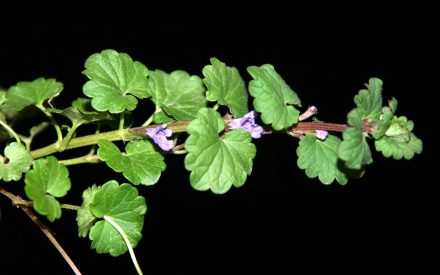 Controlling Creeping Charlie, Gleochoma hederaceae
Controlling Creeping Charlie, Gleochoma hederaceae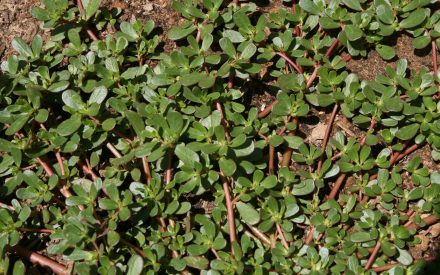 Common Purslane, Portulaca oleracea
Common Purslane, Portulaca oleracea


